Labour will face a renewed attack from the Green party in key marginal seats at this general election, as the group known primarily for its climate stance tries to reach voters who want radical change rather than centrism.
In sharp contrast to all of the main parties, the Greens will make an unabashed argument for higher taxes, which they will say are needed to fund the NHS, education and other priorities, alongside their call much stronger action on the climate crisis.
According to recent YouGov polling, the Green party is particularly strong among younger voters, coming in second place among under 30s, above the Tories and Liberal Democrats. Local elections showed voters moving to the Greens from the Liberal Democrats, and even from the Conservatives.
James Crouch, the head of policy and public affairs research at Opinium, said: “The landscape of the left of centre is more complicated now – voters who might have looked to the Liberal Democrats for an alternative to the two main parties now have the Greens as well.”
Many of the Green party’s target voters are likely to come from Labour, however, disenchanted by Keir Starmer’s stance on the war in Gaza and the watering down of Labour’s commitment to invest £28bn a year on reaching net zero greenhouse gas emissions. Labour lost seats to the Greens in May’s local elections in Bristol, Stroud, Newcastle, South Tyneside and other areas, including those with high Muslim populations, thought to be a reaction to Labour’s stance on Gaza.
The Green party leadership is only focusing on four seats they think can be won: Brighton Pavilion, held by the outgoing Caroline Lucas since 2010; Bristol Central, a newly created seat, to be contested by the party co-leader Carla Denyer; Waveney Valley, another new seat straddling Norfolk and Suffolk, where co-leader Adrian Ramsay will stand; and North Herefordshire.
The Green party and its Scottish counterparts are aiming to field a full slate of candidates across the UK, and this could present a problem for Starmer in some key marginals, where Labour’s chances of winning could be thwarted by the size of the Green party vote.
The Guardian identified 14 constituencies at the last general election, or byelections since, which the Conservatives won with a majority over Labour that was less than the number of votes cast for the Greens.
In a handful more, the Green vote was greater than the margin by which the Conservatives won over the Liberal Democrats, or by which the Scottish National Party won over the Liberal Democrats or Labour. Some of these constituencies will be affected by boundary changes, so it is not possible to map them neatly on to current seats.
The seats where Green party votes made a significant difference at the last election included ”red wall” seats such as Bury, Blyth Valley and North West Durham, as well as Kirkcaldy and Cowdenbeath in Scotland. In Stroud the Greens had a particularly strong performance, polling almost 5,000 votes, which was considerably more than the 3,840 votes by which the Conservatives won over Labour. In Vale of Glamorgan, another area where the Greens enjoy sizeable support, their vote was within 10% of the majority of 3,562 by which the Conservatives took the seat.
Only four of these 14 constituencies will remain intact after the boundary changes that have been put in place for this election, so it is difficult to estimate how many constituencies could be affected by the Green vote.
Some local Labour parties have suggested the Greens should hold back to avoid splitting the leftwing vote. This has angered the Greens. No one votes for the Greens by accident, they point out, and it’s patronising to suggest their voters don’t know what they’re doing. The number of seats where the Greens could split the leftwing vote is likely to be small, not enough to prevent a Labour victory if the polls are correct. And tactical voting often happens in a first-past-the-post system – the Greens are among the strongest advocates for proportional representation.
The effect on Labour is likely to be slightly less than the impact of the Reform Party on the Conservative vote: the Greens are polling consistently at about 6% or 7% of the vote, while Reform is at about 10% – 11%.
Labour’s vote share is also much higher in urban areas, according to Anthony Wells, the head of political polling at YouGov, who said: “The biggest gain in support [for the Greens] is from people unhappy with Labour moving to more centrist ground, and unhappy about Gaza. But these people are more concentrated in seats that Labour is likely to hold quite comfortably, in areas such as London and major cities.”
Carla Denyer, the co-leader of the Green Party and parliamentary candidate for Bristol Central, told the Guardian: “With Labour so far ahead in every single poll, the outcome of this election is not in doubt. But voters are disappointed that what Labour is offering is nowhere near ambitious enough to tackle the crises we’re facing. The voters I talk to in Bristol, Brighton and around the country tell me that politics is broken and they don’t want more of the same. They want real change.”
This article was written by Ashley Kirk, Fiona Harvey and Helena Horton from The Guardian and was legally licensed through the DiveMarketplace by Industry Dive. Please direct all licensing questions to legal@industrydive.com.

